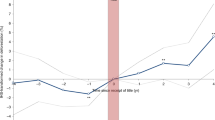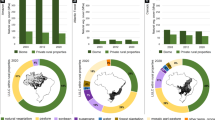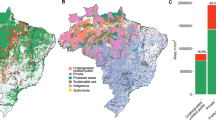Abstract
An analysis of data on property size and type as well as land use reveals the distribution of deforestation, remaining forest cover and carbon stocks in Mato Grosso, Brazil’s third largest state. Nearly two-thirds of remaining forests and carbon reserves, equating to between 2 and 3 Pg of carbon, are located on private properties. Around 80% of forests and carbon reserves are on properties larger than 1,000 ha, with smallholder farms and public land reform settlements controlling only a tiny fraction of the state’s remaining forest and carbon reserves. Efforts to reduce emissions from deforestation and forest degradation must target owners controlling most of the remaining forest and land types with the highest deforestation rates. We thus suggest that policymakers seeking to protect the remaining forest should focus both incentives and enforcement of anti-deforestation laws in the larger properties where most of these forests are located.
This is a preview of subscription content, access via your institution
Access options
Subscribe to this journal
Receive 12 print issues and online access
$209.00 per year
only $17.42 per issue
Buy this article
- Purchase on Springer Link
- Instant access to full article PDF
Prices may be subject to local taxes which are calculated during checkout





Similar content being viewed by others
References
Nepstad, D. et al. Slowing Amazon deforestation through public policy and interventions in beef and soy supply chains. Science 344, 1118–1123 (2014).
Assunção, J., Gandour, C. C. & Rocha, R. Climate Policy Initiative (CPI) Working Paper 3 (Pontífica Universidade Católica (PUC), 2012).
Arima, E. Y., Barreto, P., Araújo, E. & Soares-Filho, B. Public policies can reduce tropical deforestation: Lessons and challenges from Brazil. Land Use Policy 41, 465–473 (2014).
Gibbs, H. et al. Brazil’s soy moratorium. Science 347, 377–378 (2015).
Börner, J., Marinho, E. & Wunder, S. Mixing carrots and sticks to conserve forests in the Brazilian Amazon: A spatial probabilistic modeling approach. PLoS ONE 10, e0116846 (2015).
Godar, J., Gardner, T. A., Tizado, E. J. & Pacheco, P. Actor-specific contributions to the deforestation slowdown in the Brazilian Amazon. Proc. Natl Acad. Sci. USA 111, 15591–15596 (2014).
Hansen, M. C. et al. High-resolution global maps of 21st-century forest cover change. Science 342, 850–853 (2013).
Galford, G. L. et al. Historical carbon emissions and uptake from the agricultural frontier of the Brazilian Amazon. Ecol. Appl. 21, 750–763 (2011).
Walker, R. et al. Ranching and the new global range: Amazônia in the 21st century. Geoforum 40, 732–745 (2009).
Fearnside, P. M. Deforestation in Brazilian Amazonia: History, rates, and consequences. Conserv. Biol. 19, 680–688 (2005).
Pfaff, A. What drives deforestation in the Brazilian Amazon? Evidence from satellite and socioeconomic data. J. Environ. Econ. Manage. 37, 26–43 (1999).
Richards, P. D., Myers, R. J., Swinton, S. M. & Walker, R. T. Exchange rates, soybean supply response, and deforestation in South America. Glob. Environ. Change 22, 454–462 (2012).
Macedo, M. et al. Decoupling of deforestation and soy production in the southern Amazon during the late 2000s. Proc. Natl Acad. Sci. USA 109, 1341–1346 (2012).
Malingreau, J. P., Eva, H. D. & Miranda, E. E. Brazilian Amazon: A significant five year drop in deforestation rates but figures are on the rise again. Ambio 41, 309–314 (2012).
Peres, C. A. & Schneider, M. Subsidized agricultural resettlements as drivers of tropical deforestation. Biol. Conserv. 151, 65–68 (2012).
Aldrich, S. P. et al. Land-cover and land-use change in the Brazilian Amazon: Smallholders, ranchers, and frontier stratification. Econ. Geogr. 82, 265–288 (2006).
Caldas, M. et al. Theorizing land cover and land use change: The peasant economy of Amazonian deforestation. Ann. Assoc. Am. Geogr. 97, 89–110 (2007).
Caviglia-Harris, J. L., Sills, E. & Mullan, K. Migration and mobility on the Amazon frontier. Popul. Environ. 1–32 (2012).
Ludewigs, T., D’antona, A. d. O., Brondízio, E. S. & Hetrick, S. Agrarian structure and land-cover change along the lifespan of three colonization areas in the Brazilian Amazon. World Dev. 37, 1348–1359 (2009).
Rajão, R., Azevedo, A. & Stabile, M. C. C. Institutional subversion and deforestation: Learning lessons from the system for the environmental licencing of rural properties in Mato Grosso. Publ. Admin. Dev. 32, 229–244 (2012).
Azevedo, A. A. & Saito, C. H. O perfil dos desmatamentos em Mato Grosso, após implementação do licenciamento ambiental em propriedades rurais. CERNE 19, 111–122 (2013).
Chomitz, K. M. & Wertz-Kanounnikoff, S. Measuring the Initial Impacts on Deforestation of Mato Grosso’s Program for Environmental Control Vol. 3762 (World Bank Publications, 2005).
Wertz-Kanounnikoff, S. A. Forest Policy Enforcement at the Amazon Frontier: The Case of Mato Grosso, Brazil PhD thesis, Univ. Heidelberg (2005).
Alves, H. Q., Junqueira, R. G. P. & Bellei, F. Geoprocessamento como Ferramenta para averiguar o Cadastro Ambiental Rural realizado no estado de Mato Grosso. Anais do XV SBSR 4225–4232 (2011).
MMA Plano De Ação Para Prevenção E Controle Do Desmatamento Na Amazônia Legal (PPCDAm) (Ministério do Meio Ambiente, 2013).
Börner, J., Wunder, S., Wertz-Kanounnikoff, S., Hyman, G. & Nascimento, N. Forest law enforcement in the Brazilian Amazon: Costs and income effects. Glob. Environ. Change 29, 294–305 (2014).
Wunder, S. The efficiency of payments for environmental services in tropical conservation. Conserv. Biol. 21, 48–58 (2007).
Pinho, P. F. et al. Ecosystem protection and poverty alleviation in the tropics: Perspective from a historical evolution of policy-making in the Brazilian Amazon. Ecosyst. Serv. 8, 97–109 (2014).
Weinhold, D., Killick, E. & Reis, E. J. Soybeans, poverty and inequality in the Brazilian Amazon. World Dev. 52, 132–143 (2013).
VanWey, L. K., Spera, S., de Sa, R., Mahr, D. & Mustard, J. F. Socioeconomic development and agricultural intensification in Mato Grosso. Phil. Trans. R. Soc. Lond. B 368, 20120168 (2013).
Richards, P., Pellegrina, H., VanWey, L. & Spera, S. Soybean development: The impact of a decade of agricultural change on urban and economic growth in Mato Grosso, Brazil. PLoS ONE 10, e0122510 (2015).
Arima, E., Richards, P. D., Walker, R. & Caldas, M. Statistical confirmation of indirect land use change in the Amazon. Environ. Res. Lett. 6, 024010 (2011).
Richards, P. D., Walker, R. T. & Arima, E. Y. Spatially complex land change: The indirect effect of Brazil’s agricultural sector on land use in Amazonia. Glob. Environ. Change 29, 1–9 (2014).
Barona, E., Ramankutty, N., Hyman, G. & Coomes, O. The role of pasture and soybean in deforestation of the Brazilian Amazon. Environ. Res. Lett. 5, 024002 (2010).
Lapola, D. M. et al. Indirect land-use changes can overcome carbon savings from biofuels in Brazil. Proc. Natl Acad. Sci. USA 107, 3388–3393 (2010).
Morton, D. C. et al. Cropland expansion changes deforestation dynamics in the southern Brazilian Amazon. Proc. Natl Acad. Sci. USA 103, 14637–14641 (2006).
Gollnow, F. & Lakes, T. Policy change, land use, and agriculture: The case of soy production and cattle ranching in Brazil, 2001–2012. Appl. Geogr. 55, 203–211 (2014).
IMEA Projeções do Agronegócio em Mato Grosso para 2022 (Agribusiness Projections in Mato Grosso for 2022) (Instituto Mato-Grossense de Economia Agropecuária, 2012).
IBGE 2006 Agricultural Census (Brazilian Institute of Geography and Statistics (Instituto Brasileiro de Geografia e Estatística), 2006).
White, A. & Martin, A. Who Owns the World’s Forests (Forest Trends, 2002).
Dachang, L. Tenure and management of non-state forests in China since 1950: A historical review. Environ. History 6, 239–263 (2001).
Robbins, A. S. T. & Harrell, S. Paradoxes and challenges for China’s forests in the reform era. China Q. 218, 381–403 (2014).
Yin, R., Yao, S. & Huo, X. China’s forest tenure reform and institutional change in the new century: What has been implemented and what remains to be pursued? Land Use Policy 30, 825–833 (2013).
Cotula, L. Land Grab or Development Opportunity?: Agricultural Investment and International Land Deals in Africa (Iied, 2009).
Hall, R. Land grabbing in Southern Africa: The many faces of the investor rush. Rev. Afr. Polit. Econ. 38, 193–214 (2011).
Palmer, C. & Engel, S. For better or for worse? Local impacts of the decentralization of Indonesia’s forest sector. World Dev. 35, 2131–2149 (2007).
Saatchi, S. S., Houghton, R. A., Alves, D. & Nelson, B. (Oak Ridge National Laboratory Distributed Active Archive Center, 2009).
Baccini, A. et al. Estimated carbon dioxide emissions from tropical deforestation improved by carbon-density maps. Nature Clim. Change 2, 182–185 (2012).
INPE PRODES—Projeto de Monitoramento do Desmatamento na Amazônia Brasileira por Satélite (Monitoring Deforestation in the Brazilian Amazon by Satellite Project) (2015); http://www.obt.inpe.br/prodes.
Houghton, R., Lawrence, K., Hackler, J. & Brown, S. The spatial distribution of forest biomass in the Brazilian Amazon: A comparison of estimates. Glob. Change Biol. 7, 731–746 (2001).
Fang, J., Chen, A., Peng, C., Zhao, S. & Ci, L. Changes in forest biomass carbon storage in China between 1949 and 1998. Science 292, 2320–2322 (2001).
Soares-Filho, B. et al. Cracking Brazil’s forest code. Science 344, 363–364 (2014).
Acknowledgements
We would like to acknowledge the support of National Science Foundation Grant, Brazil’s New Green Revolution: Capital, Investment, and Agricultural Expansion, grant no. 1305489.
Author information
Authors and Affiliations
Contributions
P.D.R. devised the study. P.D.R. and L.V. designed the experiments. P.D.R. conducted the experiments. P.D.R. and L.V. wrote the manuscript. All authors approved this manuscript.
Corresponding author
Ethics declarations
Competing interests
The authors declare no competing financial interests.
Supplementary information
Rights and permissions
About this article
Cite this article
Richards, P., VanWey, L. Farm-scale distribution of deforestation and remaining forest cover in Mato Grosso. Nature Clim Change 6, 418–425 (2016). https://doi.org/10.1038/nclimate2854
Received:
Accepted:
Published:
Issue Date:
DOI: https://doi.org/10.1038/nclimate2854
This article is cited by
-
Importance of legislation for maintaining forests on private properties in the Brazilian Cerrado
Environment, Development and Sustainability (2022)
-
Cattle vaccination records question the impact of recent zero-deforestation agreements in the Amazon
Regional Environmental Change (2018)



